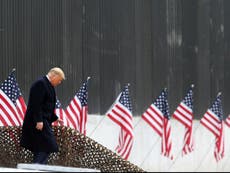A timeline to insurrection: The Trump tweets that security experts say led to the Capitol riots
NYU’s Just Security forum says ‘evidence shows how the president inspired violent groups’
Your support helps us to tell the story
From reproductive rights to climate change to Big Tech, The Independent is on the ground when the story is developing. Whether it's investigating the financials of Elon Musk's pro-Trump PAC or producing our latest documentary, 'The A Word', which shines a light on the American women fighting for reproductive rights, we know how important it is to parse out the facts from the messaging.
At such a critical moment in US history, we need reporters on the ground. Your donation allows us to keep sending journalists to speak to both sides of the story.
The Independent is trusted by Americans across the entire political spectrum. And unlike many other quality news outlets, we choose not to lock Americans out of our reporting and analysis with paywalls. We believe quality journalism should be available to everyone, paid for by those who can afford it.
Your support makes all the difference.Donald Trump can no longer attack his enemies and stoke political division on Twitter.
But before he was de-platformed across social media, he expertly used his account to disperse dangerous rhetoric and push wild election conspiracy theories to his 88 million followers.
That rhetoric eventually led to insurrection and bloodshed at the Capitol, when Mr Trump’s supporters violently tried to prevent lawmakers from certifying Joe Biden’s election victory.
Now, the New York University School of Law’s “Just Security” group says it has identified the key tweets and incendiary attacks from Mr Trump’s final year in office that culminated in the attack.
The group, which analyses US national security law and policy, pinpointed 14 of the outgoing president’s tweets, and 10 inflammatory speeches that it claims created the conditions for his supporters to try to derail the democratic process in his name.
From refusing to condemn white supremacists, to boosting the Proud Boys and QAnon, refusing to guarantee a peaceful transfer of power and urging his supporters to ‘Stop the Steal’, the group says the president ‘inspired’ the violence that shocked the world.
The Just Security timeline begins on 20 January 2020, when Mr Trump took to Twitter to express his support for heavily armed 2nd amendment protestors in Richmond, Virginia.
“The Democrat Party in the Great Commonwealth of Virginia are working hard to take away your 2nd Amendment rights,” he tweeted.
Later, as the country struggled to come to terms with the coronavirus outbreak, Mr Trump decided to politicise the pandemic.
On 17 April, Mr Trump tweeted his support for armed anti-coronavirus lockdown protests at a number of state capitals.
“LIBERATE MINNESOTA!” “LIBERATE MICHIGAN!” and “LIBERATE VIRGINIA, and save your great 2nd Amendment. It is under siege!”, he tweeted.
The tweets saw former acting US assistant attorney general for national security Mary McCord write that Mr Trump had “incited insurrection” against state governments.
Professor Ryan Goodman, Just Security’s editor-in-chief, says that their timeline shows how Mr Trump constructed a hostile environment that would end with his supporters rejecting democracy.
“The timeline shows how President Trump's statements on the day of the attack of the Capitol were part of a long and consistent pattern of behaviour on his part driving people to the point of violently storming the Capitol,” said Mr Goodman.
"The timeline tracks 365 days that built up to that moment. It shows how the president often glorified violence as a tool to confront perceived political enemies. It is no wonder the mob followed through.”
The group also highlights Mr Trump’s backing of supporters in Texas, who just days before the election surrounded a Biden campaign bus with their cars and trucks.
“I LOVE TEXAS,” he tweeted with a video of the incident.
“These patriots did nothing wrong,” he later tweeted when the FBI started an investigation.
The group also highlighted a string of “Stop the Steal” tweets made by Mr Trump ahead of the fateful 6 January rally.
Noah Bookbinder, executive director of US government watchdog Citizens for Responsibility and Ethics in Washington, says Mr Trump’s weaponising of false election fraud claims started way before the first vote was cast.
“For months before the election, Donald Trump made the false case that there would be widespread voter fraud due to the increase in voting by mail, which was in fact a necessary and appropriate response to the pandemic,” he said.
"After the election, he repeated strongly and continuously to his supporters the false claims that he had really won the election, that there was widespread fraud, and that the election was being stolen.
“The upshot was that, even though President Trump had clearly lost in an election that was not particularly close, millions of Americans were whipped into a frenzy based on false stories of a stolen election.”
Just Security also looked at how the president’s speeches, interviews and presidential debates added to the fuelling of his MAGA base’s resentment about the election outcome.
And they pointed to Mr Trump’s response during the first presidential debate on 29 September, when he was asked to condemn white supremacist groups like the Proud Boys.
Instead of doing that he told them to “Stand back and stand by” and added that “somebody’s got to do something about Antifa and the left”.
The comment was widely viewed as a boost for the far-right group, and an endorsement from the White House.
Mr Goodman says that Mr Trump’s hateful speech may be of interest to prosecutors once he has left office.
“The timeline is relevant to federal criminal prosecutors and the office of the attorney general of the District of Columbia, who may need to decide whether Trump’s speech led to foreseeable violence,” he added.
"The evidence shows several times in which President Trump could have called off white supremacist groups like the Proud Boys.
“He could have made clear that they were not welcome at any of these political events or in efforts to overturn the election.”
Harvard University’s Susan Benesch, of the Dangerous Speech Project, says Mr Trump “has a knack” of using language that his supporters would understand as “a call to violence”
“When that happens, Trump could easily correct them, but he fails to do so," she says.
Some of Trump’s more problematic comments, identified by experts
“The Democrat Party in the Great Commonwealth of Virginia are working hard to take away your 2nd Amendment rights”
“LIBERATE MINNESOTA!” “LIBERATE MICHIGAN!” and “LIBERATE VIRGINIA, and save your great 2nd Amendment. It is under siege!”
“These patriots did nothing wrong” (after a group surrounded Biden’s tour bus)
To the Proud Boys: “Stand back and stand by”
“You’ll never take back our country with weakness. You have to show strength, and you have to be strong”
"By his silence, he reinforces their sense that ‘we have marching orders’, to Trump’s invitation to come to Washington DC to protest and perhaps disrupt the US Congress’ certification of Joe Biden as the next president. ‘Be there, will be wild’: Trump did not have to explain what ‘wild’ meant – his most violence-hungry supporters were glad to fill that in.”
Mr Trump was impeached in the House on Wednesday for “incitement of insurrection” following the mayhem.
Lawmakers pointed to Mr Trump’s angry speech on the morning of 6 January in which he encouraged his supporters to march on the US Capitol.
“We’re going to walk down to the Capitol and we’re going to cheer on our brave senators and congressmen and women and we’re probably not going to be cheering so much for some of them,” he said.
“You’ll never take back our country with weakness. You have to show strength, and you have to be strong.”
Jennifer Mercieca, of Texas A&M University, is a historian of American political rhetoric and has studied the style used by Mr Trump.
“I understand that Trump claims that people who read his speech thought it was appropriate. It was not appropriate. He used war rhetoric and incited a violent insurrection against the United States,” she says.
"He was a general motivating his troops. His troops then stormed the Capitol, just like he asked them to do.
"He ended the speech, ‘So let’s walk down Pennsylvania Avenue. I want to thank you all. God bless you and God bless America. Thank you all for being here, this is incredible.’
“There isn't a great battle plan in the speech, Trump isn't much of a planner, to be honest.
"He tells his crowd that everything is on the line, a great injustice against them and the pure nation is happening and they are all powerful and can stop it (somehow). Then tells them to march.”
Mr Trump’s actions had long prepared his followers for the idea that democracy could be sacrificed for him, according to Mr Bookbinder, whose group filed a criminal complaint against Mr Trump for trying to overthrown the US government.
“We can see that the roots of the president's call for insurrection go well beyond the past few weeks or even months,” added Mr Bookbinder.
"His refusal on many occasions to condemn violence from his supporters, including his equivocal comments about white supremacists at a rally in Charlottesville and his admonition to the violent Proud Boys organisation to ‘stand back and stand by’, sent the signal that he tacitly approved of violence by his supporters.
“Similarly, his constant eroding of democratic checks and balances and nonstop use of the presidency to enrich himself through his businesses sent the message to his supporters that his personal interests outweighed those of the country and that the democracy could appropriately be sacrificed for Donald Trump's advancement.”
Mr Trump was first impeached in 2019 over his efforts to pressure Ukraine to investigate Mr Biden and his family.
Most Democratic Senators have called for Mr Trump’s immediate removal from office, including the two independent senators, Maine’s Angus King and Vermont’s Bernie Sanders.
While the House needed only a simple majority to impeach Mr Trump, the Senate requires two-thirds, or 67 senators, to convict.
Republican Senator Pat Toomey, of Pennsylvania, has called on Mr Trump to resign but has also said it is not “practical” to remove him with just days left of his administration.
Alaska’s Republican senators, Dan Sullivan and Lisa Murkowski, have also not ruled out convicting Mr Trump, while Mitch McConnell says he has “not made a final decision” on how he would vote.
Nebraska’s Ben Sasse has said it was “obvious” that Mr Trump had been “derelict in his duty to defend the constitution” but has not said if he would vote against him.
Mitt Romney, of Utah, was the only Republican senator to vote to convict Mr Trump during his first impeachment, while Maine’s moderate GOP senator Susan Collins is also viewed as a potential vote against the president
After his impeachment Mr Trump issued a video statement in which he claimed to have been “shocked” by the violence and totally opposed to it as he condemned those supporters he was viewed as having egged on.
“In the Senate trial, a lot will turn on the credibility of the president's claiming he opposed the assault on the Capitol and could not have foreseen it,” concluded Mr Goodman.
“The timeline provides evidence to assess the credibility of that defense.”
The White House has not responded to a request for comment.




Join our commenting forum
Join thought-provoking conversations, follow other Independent readers and see their replies
Comments